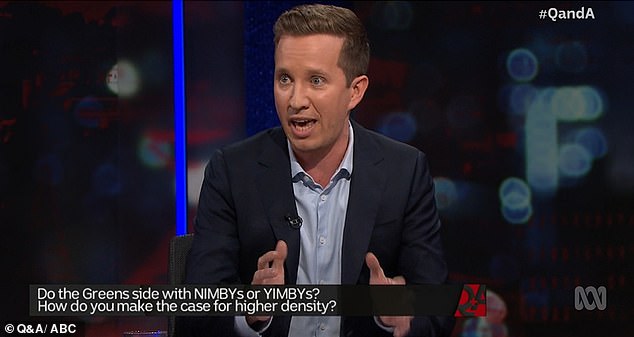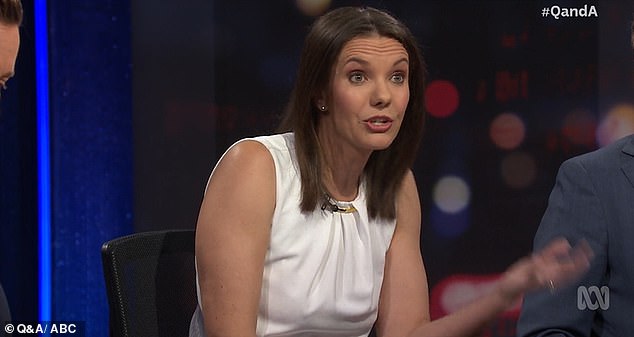Greens MP Max Chandler-Mather and NSW Labor minister Rose Jackson make extraordinary comments on ABC Q&A about Australia’s housing crisis – and they will anger many Aussies
Greens and Labor politicians responsible for their parties’ housing policies have denied that record high levels of immigration are to blame for Australia’s housing affordability crisis – contradicting the views of some of the country’s most respected economists.
A record number of 548,800 migrants moved to Australia over the year to September, coinciding with rental vacancy rates at a record low one per cent.
The average house price in Sydney has also risen 11.7 per cent in the past year to an even more unaffordable $1.4 million, even after the Reserve Bank hiked interest rates 13 times in 18 months to a 12-year high of 4.35 percent.
New South Wales had to accommodate 186,433 new migrants in a year – or a third of Australia’s new arrivals, most of whom went to overcrowded Sydney.
But Max Chandler-Mather, the Greens’ spokesperson on housing and homelessness, denied that high immigration is behind unaffordable housing during an appearance on ABC’s Q+A program on Monday evening.
Greens and Labor politicians in charge of housing policy have denied that record high levels of immigration are responsible for Australia’s affordability crisis (pictured are houses in Oran Park in Sydney’s far south west)
“Politicians don’t want to talk about building public housing, they don’t want to talk about rent caps,” the Brisbane-based MP said.
“Planning is not the barrier to a housing crisis, and like immigration, it is a distraction used to avoid talking about what we have done in the past.”
Mr Chandler-Mather said the 50 per cent capital gains tax credit introduced in 1999 for investors and landlords had ensured house price growth far outpaced wage growth.
“We didn’t have capital gains tax relief and we didn’t have a tax system that encouraged people to look at housing as a huge, lucrative investment,” he said.
Mr Chandler-Mather overlooked how net overseas immigration levels tripled between 1998 and 2008, from 88,781 to 315,700, before hitting new record levels since Australia reopened in late 2021.
NSW Minister for Labour, Housing and Homelessness Rose Jackson suggested concerns about high immigration were an obsession for conservative political commentators on Sky News.
‘Easy answers are always attractive: yes, talk about migrants. But you know what, this isn’t Sky After Dark,” she said.
Ms Jackson, a supporter of more social housing, also suggested her federal Labor colleagues review negative gearing and the 50 per cent capital gains tax credit.

Max Chandler-Mather, the Greens’ housing spokesman, denied that high immigration is behind unaffordable housing during an appearance on ABC’s Q+A program on Monday evening.
This is despite former federal Labor leader Bill Shorten losing the 2019 election and promising to do just that, meaning Jackson’s husband Sam Crosby also failed in his bid to win the seat of Reid in Sydney’s inner west.
“I’m for whatever is on the table,” she said.
“One thing I won’t do is take the easy way out for a state politician and say, ‘It’s actually the Commonwealth’s problem, they need to improve their tax system and immigration,’” she said.
AMP chief economist Shane Oliver has drawn a link between unaffordable housing and high immigration causing a housing shortage.
“The role of high levels of immigration cannot be ignored,” he said.
‘There has been much discussion for years about poor housing affordability in Australia, but the debate about the contribution of immigration to this problem is often missing.’
In the year to September, Australia built 170,215 homes and units, a level well below the net overseas migration level of 548,742 for the same period, Australian Bureau of Statistics data shows.
ABC finance commentator Alan Kohler noted in his Quarterly Essay The Great Divide: Australia’s Housing Mess and How To Fix It that turbo-immigration and the capital gains tax cut had led to house prices outpacing wage growth since 2000, when John Howard was Liberal was prime minister.
“The increase in immigration under Howard was part of his industrial relations strategy to crush unions and suppress wage growth, and the crackdown on refugees was deliberately designed to cover this – to give the impression that the opposite was happening.” , he said.
‘The other consequence of Howard’s wave of immigration was a shortage of housing, because no thought was given at all to where the newcomers might live.’
Decades before, average full-time wages and home prices had consistently risen at a similar pace.
Until the 1990s, an average full-time worker could still afford a median-priced home in Sydney or Melbourne, at a time when annual net immigration levels were mainly in the five-digit range.
This meant that the average worker with a 20 percent mortgage could buy a normal house for less than six times his salary.

NSW Minister for Employment Housing and Homelessness Rose Jackson suggested concerns about high immigration were an obsession for conservative political commentators on Sky News
In Sydney, someone with an average salary of $98,218 would now be unable to buy a home with an average price of $1.396 million as this would mean borrowing 11.3 times income, even with a 20 per cent deposit .
Banks are now reluctant to lend anyone more than 5.2 times their salary, with a debt-to-income ratio of ‘6’ considered risky.
The situation is so dire that someone earning $214,739 and borrowing $1.117 million is in mortgage stress, paying 38 percent of their salary in mortgage repayments – despite being in the top 2.3 percent of income earners.
Mortgage stress occurs when someone spends more than 30 percent of their salary (excluding tax) on paying off a mortgage, which often means that significant cuts are made on other necessities of life.
